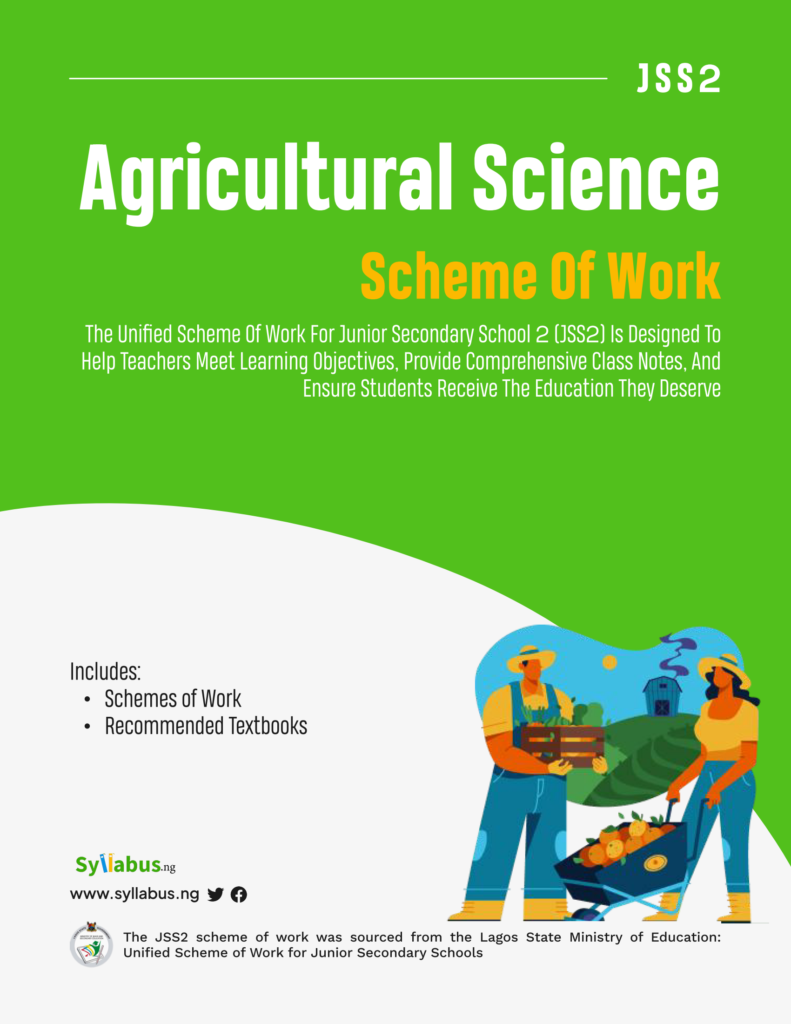JSS2 Agricultural Science Scheme of Work
Download the Junior Secondary School 2 (JSS2) Unified Scheme of Work for Agricultural Science to serve as a guide for educators

Home » JSS2 Scheme of Work » JSS2 Agricultural Science Scheme of Work
Home » JSS2 Scheme of Work » JSS2 Agricultural Science Scheme of WorkAbout JSS2 Agricultural Science Scheme of Work
Security Education forms a crucial part of the syllabus for students in Junior Secondary School 2 (JSS2). This subject is designed to provide students with the necessary knowledge and abilities to comprehend various aspects of security, safety, and personal protection within their communities and beyond.
The scheme of work covers topics like crime prevention and emergency management. Through both theoretical teachings and practical activities, students gain insights into potential risks and strategies for risk reduction, nurturing a sense of accountability toward their safety and that of others.
Security Education in JSS2 helps to shape students into informed and proactive citizens, ready to contribute to the security and well-being of their communities.
Assessment Guide
In junior secondary schools, how students are assessed in Security Education can differ from school to school. However, typically, they are evaluated through tests or oral quizzes (Continuous Assessment Tests) and end-of-term exams.
Grading usually follows a scale from A to F, with A representing excellent performance, typically scoring around 70% or 80%, and F indicating failure, usually below 40%
Download JSS2 Agricultural Science Scheme of Work

Know what’s expected of you as an educator
Download the Lagos State Unified Scheme of Work for JSS2 Agricultural Science
JSS2 First Term Scheme of Work for Agricultural Science
| LAGOS STATE MINISTRY OF EDUCATION: UNIFIED SCHEMES OF WORK FOR JUNIOR SECONDARY SCHOOL | ||
| Agricultural Science Scheme of Work for Junior Secondary School 2(JSS2) | ||
| Class | J.S.S 2 | |
| Subject | Agricultural Science | |
| Term | First Term | |
| Week | Topic | Breakdown |
| 1 | GENERAL CLEANING AND REVISION ON PROBLEMS OF FARM MANAGERS | |
| 2 | FARM STRUCTURES AND BUILDING | I. Types of Farm Structures and Uses II. Maintenance of Farm Structures and Building |
| 3 | SITTING OF FARM AND LAYOUT OF FARM STRUCTURES | I. Factors Guiding Sitting of Farm Structures II. Factors Guiding Layout of Farm Structures III. Importance of Siting Farm Structures |
| 4 | CULTURAL PRACTICES | I. Definition of Cultural Practices II. Explain Pre – Planting Operations – Harrowing, Ploughing, Ridging, etc |
| 5 | CULTURAL PRACTICES | I. Define Planting Operations II. State/List Various Planting Operations III. Planting/Sowing –Thinning, Spacing, Depth IV. Supplying Planting Distances, etc |
| 6 | CULTURAL PRACTICES | I. Post Planting Operation II. Fertilizer Application III. Explain Methods of Fertilizer Application IV. Explain Methods of Harvesting Different Types of Crops • Harvesting • Storage • Processing |
| 7 | AGRICULTURAL PRACTICES | I. Definition of terms Farming Systems – Mixed Farming, etc. II. Cropping Systems – Mono Cropping, Sole Cropping, Mixed Cropping, etc. III. State Advantages and Disadvantages of Each System. |
| 8 | AGRICULTURAL PRACTICES | State Advantages and Disadvantages of each of the Systems |
| 9 | FIELD WORK | I. Students are to practice all they have been taught on the field II. Practice all the farm practice – Planting, Pre – planting and Post – Planting Operations |
| 10 | REVISION | |
| 11-12 | EXAMINATION | |
JSS2 Second Term Scheme of Work for Agricultural Science
| Term | Second Term | |
| Week | Topic | Breakdown |
| 1 | GENERAL CLEANING AND REVISION ON TYPES OF FARM STRUCTURES AND BUILDINGS | |
| 2 | ANIMALS FEED AND FEEDING | I. Meaning of Feed II. Types of Feed – Energy, Protein, etc. III. Mention Feeding Tools |
| 3 | CLASSIFICATION OF LIVESTOCK | I. Feeds – Protein, Energy, etc II. Identify Feed Nutrients |
| 4 | FACTORS TO CONSIDER BEFORE DECIDING ANIMAL FEEDS | I. Age II. Physiological Status III. Purpose of Rearing |
| 5 | ANIMAL PESTS AND DISEASE CONTROL | I. Define Diseases II. Causes of Diseases in Farm Animal |
| 6 | FARM ANIMAL DISEASES AND CONTROL | I. Bacteria – Mastitis, etc. Fungal, Ringworm, Viral Foot and Mouth Disease, Protozoan – Coccidiosis, Trypano – Somaisis – Worms II. State Mode of Transmission of Animal Diseases III. Identify Symptoms of Farm Animals Diseases IV. State the Effects of Diseases on the Farm Animals |
| 7 | FARM ANIMAL DISEASES | I. Bacterial and Fungal Diseases II. Modes of Transmission III. Methods of Control Symptoms |
| 8 | FARM ANIMAL DISEASES | I. Viral and Protozoan II. Examples of Animal Infected Mode of Transmission III. Symptoms and Effects Control Measures |
| 9 | FARM ANIMAL DISEASES | I. Worms and Bloat II. Identify types of worms III. Identify Types of Animals affected by these disease |
| 10 | REVISION | |
| 11-12 | EXAMINATIONS |
JSS2 Third Term Scheme of Work for Agricultural Science
| Term | Third Term | |
| 1 | REVISION AND GENERAL CLEANING | I. Disease Control II. Methods of Disease Control |
| 2 | FISHERY | I. Definition of Fishery II. Importance of Fishery – Food, Protein, Income, Medicine, etc. |
| 3 | CLASSIFICATION OF FISH | I. Based on habitat – fresh Water Fish, Marine Water Fish II. Based on morphology – Bony and Boneless fish / Cartilaginous fish |
| 4 | ESTABLISHMENT OF FISH POND | I. Factors to be considered before siting Fish Pond II. Methods of Fishing |
| 5 | ESTABLISHMENT OF FISH POND | I. Field Trip/Excursion to a nearby Fishery II. Explain how to establish a Fish Pond III. Identify Types of Fish Food |
| 6 | FOREST AND FOREST USES | I. Define Forest II. Types of Forest – Mangrove (Swampy), Rain Forest (Many Tree) and Derive forest (few trees) III. State the Characteristics of a Forest |
| 7 | FOREST RESOURCES AND THEIR USES | I. Trees, Wild Life (Animal) and Fruits II. Various Herb, Shelter, etc III. State the Uses of the Forest Resources |
| 8 | EFFECTS OF FOREST ON THE ENVIRONMENT | Explain the Effects of Forest on the Environment |
| 9 | EFFECTS OF FOREST ON THE ENVIRONMENT | I. Human Activities that Affects the Forest II. Afforestation, Deforestation, Hunting, Bush burning, Over Grazing, etc. III. State the Advantages and Disadvantages of Each |
| 10 | REVISION | |
| 11-12 | EXAMINATION |
Recommended Agricultural Science Textbooks for Junior Secondary School 2
The recommended Agricultural Science textbooks for students in J.S.S.2 include:
- Basic Agricultural Science for Junior Secondary Schools Book 2 By Olayinka Samson Arowolo, Bola Olusola Arowolo- Daystar Press Limited
- Agriculture for junior/senior secondary schools By Dairo S.D et al – Spectrum Books Ltd
- New Agricultural Science for Junior Secondary Schools By A.A Adebisi et al – Learn Africa Plc JSS 2
- Fundamental Agricultural Science By Nnoka C.N et al – Noble Publishers JSS2
- New millennium Agricultural science By Ngozi Asika. – Elochukwu Akaolisah Printing Press
All JSS2 Scheme of Work
Download JSS2 Agricultural Science Scheme of Work

Know what’s expected of you as an educator
Download the Lagos State Unified Scheme of Work for JSS2 Agricultural Science











